mobile View, to the German Version tap the flag
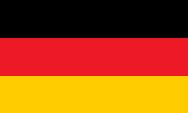

- Oriental Republic of Uruguay
- presidial republic
- own name: República Oriental del Uruguay
• Flags
• Historical Flags
• Meaning/Origin of the Flag
• Coat of Arms
• Meaning/Origin of the Coat of Arms
• Aircraft Roundel
• Map
• Numbers and Facts
• History
• Origin of the Country's Name
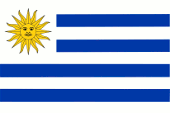
National, state, merchant and naval flag,
ratio = 2:3,
Source, by: Flags of the World





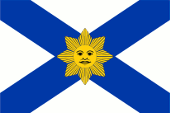
Naval jack,
ratio = 2:3,
Source, by: Flags of the World



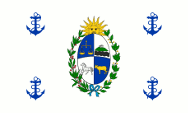
Flag of the President as Commander-in-Chief of the Armed Forces,
ratio = 3:5 (?),
Source, by: Flags of the World



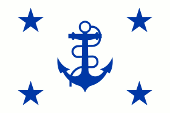
Flag of the Minister of Defense,
ratio = 2:3,
Source, by: Flags of the World



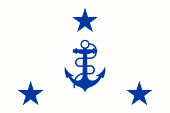
Flag of the Commander in Chief of the Navy,
ratio = 2:3,
Source, by: Flags of the World



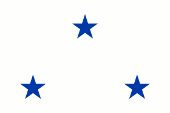
Flag of a Vice Admiral of the Navy,
ratio = 2:3,
Source, by: Flags of the World




Flag of a Rear Admiral of the Navy,
ratio = 2:3,
Source, by: Flags of the World




Flag of a Captain in Command,
ratio = 2:3,
Source, by: Flags of the World




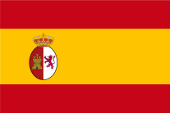
to 1810,
Flag of Spain,
ratio = 2:3,
Source, by: Flags of the World



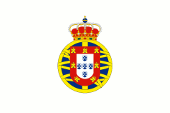
1817–1822,
National flag of the United Kingdom of Portugal, Brazil and the Algarves,
ratio = 2:3,
Source, by: Flags of the World



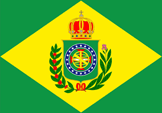
1822–1825,
Flag of Brazil,
ratio = 2:3,
Source, by: Brasil Imperial



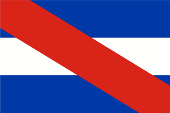
1815–1817, Uruguay / Patria vieja,
Flag of José Gervasio de Artigas,
ratio = 2:3,
Source, by: Flags of the World



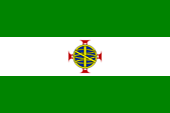
1817–1825, Brazil,
Flag of the Cisplatine Province,
ratio = 2:3,
Source, by: Flags of the World



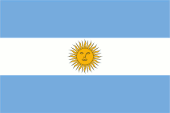
1825–1828,
Flag of the United Provinces of La Plata,
ratio = 2:3,
Source, by: Flags of the World



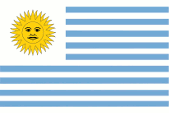
1828–1830, Uruguay,
National flag,
ratio = 2:3,
Source, by: Flags of the World



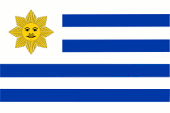
1830–1834, Uruguay,
National flag,
ratio = 2:3,
Source, by: Flags of the World



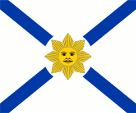
to 1934, Uruguay,
Naval jack,
ratio = 5:6,
Source, by: Flags of the World



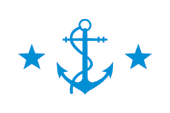
to 1934, Uruguay,
Flag of the Inspector General of the Navy,
ratio = 2:3,
Source, by: Flaggenbuch 1939



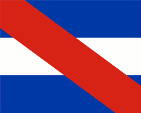
1934–ca. 1995, Uruguay,
Naval jack,
ratio = 4:5,
Source, by: Flags of the World



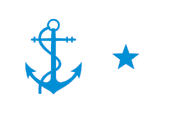
from 1934, Uruguay,
Flag of the Inspector General of the Navy,
ratio = 2:3,
Source, by: Die Welt im bunten Flaggenbild




The current flag of Uruguay was introduced on 11th of July in 1830. It shows nine horizontal stripes in white and blue and a white upper corner with a yellow sun in it. The colours of the flag go back to the Argentinian national flag, while the USA flag was the model for the design. The yellow sun in the white upper corner is the freedom sun, a symbol of freedom and independence that is widespread in almost all South American countries. The shades of the colours of the flag are not defined. The country's flag history repeatedly shows versions in predominantly lighter or darker blue, which has to do with the flavour of the time and also the age of the originals. The decisive factor in the early period was probably the indigo dye, a vegetable colouring agent that dyes to varying degrees and also washes out quickly. The flag was created in connection with the attainment of independence in 1828. It initially featured nine blue stripes to symbolise the number of provinces in the country. The large number of stripes, nine blue and ten white, caused problems in the production of the flag, so the current form was introduced on 11th of July in 1830. It now showed a total of nine stripes, five white and four blue. The number of provinces has since changed, but the design of the flag has been retained. The Uruguayan naval Jack was introduced in the mid-1990s. It shows a white bunting with a blue diagonal cross and the yellow liberty sun in the centre. A similar design was already used at the beginning of the 20th century. It is said to be used unofficially and without authorisation by the navy as a naval flag and is not only flown on the bow of warships. Another important flag of the country is the flag of José Gervasio de Artigas, the national hero of Uruguay. It shows three horizontal stripes in blue, white and blue (similar to the flag of Argentina) and a red diagonal bar. This flag was the naval jack of the Uruguayan navy from the 1930s until the 1990s. The design of the Artigas flag is still used as the emblem of the air force.
Source:
Flags of the World,
Die Welt der Flaggen,
Flaggen Wappen Hymnen,
Flaggen und Coat of arms of the Welt,
Volker Preuß


Coat of arms of Uruguay,
Source: Corel Draw 4

The national coat of arms of Uruguay, was introduced in 1829, and 1908 confirmed by law. It was designed after the pattern of the emblem of the capital Montevideo from the 18th century. It shows a quartered oval scutcheon with blue and white fields. In the first field are palced scales on blue, it stands for equality and justice, in the second field the mountain Montevideo on white, it stands for power and defensive strength, in the third field a horse on white, it stands for freedom and in the fourth field a yellow bull on blue, he stands for prosperity. Above the shield the sun of freedom. The shield is surrounded by an oil-twig and a laurel-twig, bond with a blue ribbon. They represent the freedom which was won in the fight against Brazil.
Source:
Die Welt der Flaggen,
Flaggen Wappen Hymnen,
Flaggen und Coat of arms of the Welt,
Volker Preuß

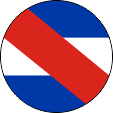
Aircraft Roundel,
Source, by: Wikipedia (EN)

Aircraft roundel for naval aircrafts,
Source, by: Wikipedia (EN)

Location:
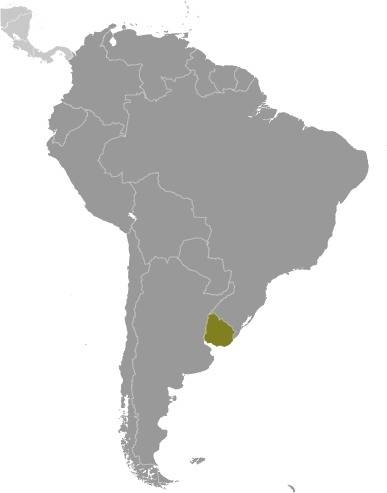
Source: CIA World Factbook
Map of the country:
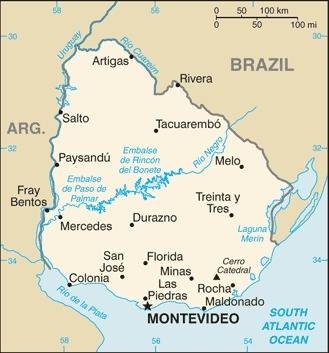
Source: CIA World Factbook

Area: 68.037 square miles
Inhabitants: 3.440.000 (2023), thereof 88% Europeans (thereof 15.000 Germans), 8% Mestizos, 4% Blacks
Religions: 47% Roman Catholic, 11% other Christian, 17% Non-Religious
Density of Population: 51 inh./sq.mi.
Capital: Montevideo, 1.338.408 inh. (2009)
official Language: Spanish
other Languages: French, Italian
Currency: 1 Uruguayan Peso (UYU, $, $U) = 100 Centésimos
Time Zone: GMT – 3 h
Source:
Wikipedia (DE)

Middle Ages · the today's Uruguay is sparsely populated by the native american tribes of the Charrúas, Guana, Yaros and Chana
1515 · the Spanish seafarer Juan Díaz de Solís discovered today's Uruguay during the crossing of Rio de la Plata in search of a western passage to India, Spain took possession of the land but initially not colonized
1680 · Founding of the colony Sacramento eastern of the River Uruguay by Portuguese and Spanish ranchers, attempts to take possession by Portugal and his Colony of Brazil
1726 · Founding of the Fortress of Montevideo by Spain
1776 · establishment of the Spanish Vice-Kingdom of Río de la Plata (today’s Bolivia, Paraguay, Uruguay, Northern Argentina, Northern Chile, and the Brazilian federal state of Rio Grande do Sul) by separation from the Vice-Kingdom of Peru, the today's Uruguay is called in this time "Banda Oriental", the "east side" of Rio de la Plata River
1806 · Montevideo is occupied by British troops
25th of may 1810 · overthrow of the Spanish Viceroy of Río de la Plata, Beginning of the fight for freedom against Spain, later proclamation of the United Provinces of La Plata
since 1811 · the national hero Jose Gervasio Artigas defends Uruguay against Argentine and Spanish conquest attempts, his army is called "Los Tupamaros"
1814 · Argentine troops conquer Montevideo
1815 · Artigas conquers Montevideo
1817 · Portugal conquers Montevideo and incorporates Banda Oriental as Province of Cisplatina to Brazil
1820 · Artigas flees to Paraguay
19th of April 1825 · Juan Antonio Lavalleja crosses the Uruguay River and marches in the country
25th of August 1825 · Declaration of independence from Brazil, back into the United Provinces of La Plata (Argentina) as an autonomous "Province Oriental""
1825–1828 · war between Uruguay and Brazil
March 1826 · the Government of the United Provinces of La Plata (Argentina) abolishes the autonomy of the "Province Oriental"
27th of August 1828 · Treaty of Rio de Janeiro between the United Provinces of La Plata (Argentina) and Brazil under the mediation of Great Britain, the independence of Uruguay is confirmed
1st of December 1828 · Separation from the United Provinces of La Plata (Argentina), proclamation of the State of Montevideo
18th of July 1830 · proclamation of the "República Oriental del Uruguay", first constitution
1836–1838 · civil war
1843–1852 · "Guerra Grande", "Big War", civil war with participation of Argentina and Brazil
1864–1870 · war of Argentina, Brazil and Uruguay (supported by France and Great Britain) against Paraguay, defeat of Paraguay, loss of 4/5 of the population and huge parts of its territory
1870–1900 · Immigration of Europeans from Italy, Spain, France and Germany
1917 · new constitution
1936 · new constitution
1966 · new constitution, re-introduction of presidential democracy
1968 · riots
1970–1972 · guerrilla war of the "Tupamaros"
1972 · Arrest of the Tupamaro leader Sendic
1973 · seizure of power by the military
1985 · democratization, elections
1992 · riots
2001 · beginning of an economic and banking crisis
Source:
Atlas zur Geschichte,
Weltgeschichte,
Discovery '97,
Wikipedia (D)

The name of the country has its roots in the River "Uruguay", which is the border in the west. "Uruguay" means in the language of the in the 19th Century eradicated Indians "river of the colorful bird". The official name of the country is: "República Oriental del Uruguay," what means "Republic in the East of Uruguay".
Source:
Handbuch der geographischen Namen,
Volker Preuß


![]()




























